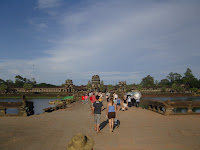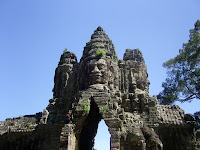

To the west of the Elephant Terrace stands a large palace, accessed from each of the four sides by steep staircases, reminding me of pictures of Mayan temples. (Just to the north of the temple was a large man-made pool – lake, really – created hundreds of years ago, which was being enjoyed by two local boys doing back flips into the water.) While an intriguing sight, we skipped the interior of the palace to go to the crown jewel of Angkor Thom, Bayon Temple.


The iconic Bayon Temple is immediately recognizable from the faces carved into its stone towers. The visages, which face the four principal directions, are representations of the bodhisattva Avalokitesvara, although the face itself apparently is of King Jayavarman. The smiling faces have been referred to as the “Mona Lisa of the East”, and they are spectacular. The temple itself is quite a structure, with numerous levels, platforms, and dark hallways opening up to quiet chambers. When French explorers discovered the temple in the early 20th Century, jungle overgrowth had covered it and scattered its stones. A great amount of work has gone into reconstructing the temple, although you still see big stones piled around the perimeter, a testament to the difficulty of rebuilding the entire structure without instructions.





What I found particularly amazing was that you could climb pretty much wherever you wanted, with few railings or stairways. Those few stairways and ladders were pretty steep and not for the faint of heart. I can’t imagine something like that in the US. Of course, there isn’t anything like Angkor Thom in the US, so I guess the comparison doesn’t really fit.
The temple is surrounded by a wall decorated with a bas relief of various scenes from local history and legend. The wall is more than one kilometre long and contains 11,000 carved figures. One could spend hours just examining the intricacies of the wall.

The day was coming to an end, however, and we wanted to see Angkor Wat during sunset, so we took the short drive just down the road to the temple complex. It is a 500 metre walk from the road across the moat to the gate of Angkor Wat and another 500 metres to the temples. Along the way from the gate to the temple, you pass elegant libraries and a lily pond that offers a reflected view of the temples. We walked around the pond, past the hawkers with their t-shirts and books and paintings towards one of the corner towers on the outside wall of the temple.




As we approached, we could hear loud banging coming from scaffolding on the tower (many of the temples are being repaired through joint ventures with different countries – Germany, France, Japan, and the US, to name a few). This was the work of a monkey, either agitated or claiming his territory. We didn’t think much of it and approached the tower, where Claire sat down on the steps to rest and fix one of her shoes. As she sat with her shoe off, however, our monkey friend decided it was time to descend and investigate. He dropped off the scaffolding onto the stairs, 25 steps and two landings above Claire. But, he spared no time in coming down. By the time I realized that the monkey was actually making a bee-line for Claire, he was only a few steps away. I yelled, “Claire, the monkey’s coming to get you!” or something similar, and she sprang up and out of the way just in time as the aggressor scurried past. It was clear he wasn't cowed by us, as he made it a point to take his own route directly through the three of us, not go around. That was one bullying monkey.

With the near-attack behind us, we decided it was time to head into the temple for a quick tour before sunset.

















